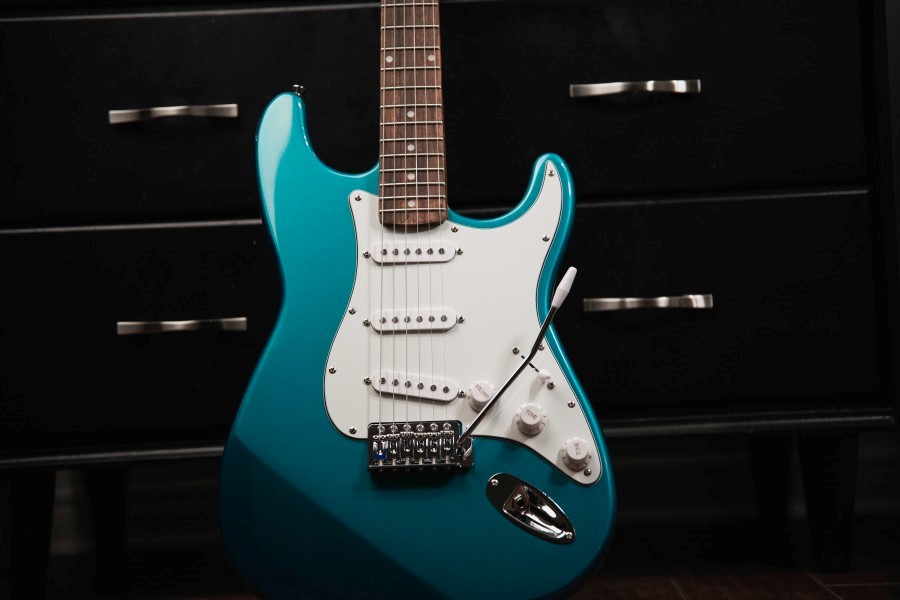Whether you’re painting a DIY guitar kit or refinishing an old favourite, choosing the best guitar finish can be challenging, so we’re here to support you in finding the right finish that is perfect for you and your refinishing project!
The Best Paints for Your Guitar
Oils and Waxes
The oldest and simplest form still is employed today for its ease of application and distinct feel.
Often rubbed onto the surface with a rag, an oil finish leaves the wood surface with a soft satin feel that can be favoured over the glossy tack of a freshly polished paint. This method does not offer the same colour selection as paint, but it does bring out the natural beauty of the wood with a rich matte finish.
Oil and wax can offer some moisture-resistant qualities, but they do not offer the same protection that other finishes do.
Oils and waxes will not affect the resonance of your instrument. The vibrations created by the strings are allowed to transfer over the wood without an additional layer of finish sitting on top.
Shellac
Shellac is made up of a natural resin produced by the Lac bug, which is most-commonly found in India. Shellac flakes are dissolved into alcohol which can be sprayed or brushed on. Once the alcohol dissolves, a thin, hard layer remains.
Shellac has been used for thousands of years and continues to be a terrific option for some projects. It works well as a sealer and is compatible with other topcoats, such as nitrocellulose.
On its own, Shellac often has a semi-gloss look. It is a very thin finish which aids in the resonance of the finish; however, its protective qualities are limited.
Nitrocellulose Lacquer
Originally developed by DuPont as an automotive finish, nitrocellulose lacquer quickly found a place in the music industry as a finish that was relatively easy to apply and repair, was compatible with a host of pigments and dyes and boasted relatively good protective qualities for the time.
In the following decades, other finishes, such as polyester and polyurethane, found a place within the guitar community. However, many builders and players still prefer as it would allow the instrument to resonate and age gracefully.
As the lacquer is exposed to UV light and other elements, the lacquer slowly degrades and begins to patina. Hairline cracks can develop to sudden environmental changes, and the finish will take on a subtle amber hue.
Several coats are required to build the lacquer to the point where it can be sanded and buffed; however, the final result is still very thin and extremely hard. It buffs to a very high gloss though it can also be applied in matte or satin.
Poly Finishes
Polyurethane and Polyester finishes have quickly become the standard for many guitar manufacturers since the golden era of the 1950s and ’60s.
Comprised of a synthetic resin, poly coats do not require as much drying time as the solvent-based nitrocellulose. They are applied much thicker, which makes them durable. However, it’s widely believed this, in fact, dampens the vibrations that flow through the instrument – a common metaphor is that poly creates a plastic shell around the guitar, choking resonance as a result.
Choosing the Right Paint Finish for a Guitar
Guitar finishes can serve several purposes, from playability to visual appeal. When selecting the type of finish on your guitar, it’s important to consider the following variables:
Protection: Traditionally, guitars are made of wood, which is very susceptible to environmental changes such as warpage due to high humidity. Finishes can also protect against damage from travel, use, etc.
Aesthetics: Since the first time some guy in Spain posted up with a guitar in the 1500s, looking good was almost as important as playing well. A great-looking instrument is just more encouraging to play. Woodgrains can be highlighted with different tints, and contrasting colours can be employed to create a visual appeal. Even the gloss level can tell the story of a new, lush instrument vs a well-worn journeyman’s tool.
Sound: A common argument for and against certain finishes is how it affects the resonance of the instrument. Some finishes sit in the woodgrain and do not impact the sound at all, while others can be much thicker and more durable but can dampen the vibrations.
Playability/Feel: The other variable to consider is how the finish feels on your fingers and hands while you play. High gloss finishes can sometimes feel a bit tacky, while satin or natural finishes often have a softer, more “played in” feel.
Many of these variables are subjective.
The importance of these variables comes down to personal preference. The best paint for a guitar body is a culmination of what you value most in an instrument. If you need help finding the right guitar finish, get in touch with us!


